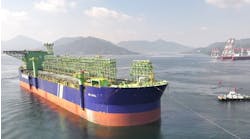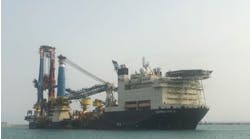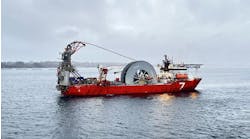The petroleum industry and governments are changing the way they view gas hydrates - the ice-like energy minerals that trap hydrocarbon gases in cold, deep waters across the globe. Sometime during this century, conventional oil and gas reserves will enter a permanent decline in production. Some energy companies are taking a long-term view and are beginning to ponder a different future from conventional oil and gas reserves.
For example, BP Amoco is already thinking about a time where oil is too expensive to burn. Thought is being given to using methane as a starting material for more complex molecules to use as liquid fuels, lubricants, and for manufacture of key chemicals. The US government is planning to increase funding to learn more about gas hydrates. Other countries, such as Japan and Germany are becoming more active, and university innovation is being brought into the picture.
When production of gas hydrate energy becomes feasible, not all hydrate accumulations will be equally economic. Instead of being disseminated in thin zones marked by bottom simulating reflectors (BSR's) across large areas, such as the Blake Plateau off the US Atlantic seaboard, gas hydrates in the Gulf of Mexico are believed to form thick vertically stacked deposits marked by seismic "wipe-out" zones.
In deep Gulf of Mexico waters, there are few BSR's, and massive seismic "wipe-out" zones marking the hydrates. Models suggest bedded gas hydrate accumulations in the ultra-deep Gulf of Mexico could be more than a kilometer thick. In contrast to other gas hydrates on the Blake Ridge that partially fill pores in sands, gas hydrates of the Gulf of Mexico occupy fracture porosity in mud, potentially enhancing volumes and production rates. In other words, there could be gas hydrate "elephants" in the Gulf of Mexico. Current leases held by energy companies in the Gulf include rights to shallow gas hydrates.
Gulf of Mexico hydrate province
The US Geological Survey suggests that 38,000 tcf of methane are trapped as gas hydrate in the Gulf of Mexico. Although the estimate is probably optimistic, the actual volume of methane in gas hydrate is still considerable. The hydrate volume is great because the Gulf of Mexico is a leaky oil and gas basin with many sites where hydrocarbons vent to the seafloor at high rates, rapidly crystallizing as gas hydrate. More than 50 gas hydrate sites have been mapped and sampled in the Gulf of Mexico by scientists at Texas A&M University.
Many gas hydrate accumulations form from oil-related gases. The minimum observed water depth of gas hydrate is about 440 meters and the maximum water depth exceeds 2,400 meters. Gas hydrate sites form a belt that extends laterally across the western Gulf of Mexico, from offshore Texas to the central Gulf offshore eastern Louisiana. The hydrate belt of the US Gulf is greater than 500 km across and is as much as 100 km in width near the center of the belt.
The total thickness of the gas hydrate stability zone (GHSZ) increases with increasing water depth. In ultra-deepwater, oil-related gas hydrate could be stable at depths in sediment greater than 1 km.
West Africa hydrate potential
In addition, there are leaky basins in deepwater off West Africa. Oil and gas are derived from deeply buried source rocks. Vertical migration occurs from great depths in the section. Because the deep source rocks are so prolific, enough oil and gas enters the subsurface petroleum system to charge large fields. Because of the dynamic geology, however, trapping efficiency is poor and much of the hydrocarbon charge is lost to the seafloor at oil seeps and gas vents.
Abundant natural oil and gas seeps have been identified in deep water off Nigeria, Angola, and other areas on the western African margin as important opportunities prior to drilling. A pattern of prolific seepage in deepwater and gas hydrate shows appear to mark West Africa as a likely area of gas hydrate accumulation.
Economic geology
Scientists are now beginning to think about the economic geology of gas hydrates in order to seek methods of production. It is not a bed of roses, however. The Blake Plateau contains an enormous volume of gas hydrate in an area the size of the State of Delaware, but the ore is dispersed as a thin film across the entire area. In water depths between two and three kilometers offshore in the Atlantic Ocean, the gas hydrates are found at only a few hundred meters depth in sediments.
Although the total in-place energy volume is great, the economics of drilling in deepwater to recover a disseminated resource at shallow depths in sediment are daunting. There are probably better places to search out economic gas hydrate accumulations, but few will have the volumes provided by such leaky offshore basins as the Gulf of Mexico and offshore West Africa.
Dr. Roger Sassen
Geochemical and Environmental Research Group
Texas A&M University


